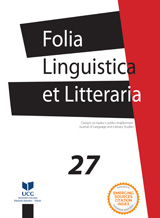SIMBOLIKA VODE U KNJIŽEVNOM NARATIVU EMINE SEVGI ÖZDAMAR
THE SYMBOLISM OF WATER IN EMINE SEVGI ÖZDAMAR'S LITERATURE
Author(s): Slavija Kabić, Eldi Grubišić PulišelićSubject(s): Comparative Study of Literature, German Literature, Turkish Literature, Theory of Literature
Published by: Filološki fakultet, Nikšić
Keywords: Emine Sevgi Özdamar; Life is a Caravanserai Has Two Doors I Came in One I Went out the Other; The Bridge of the Golden Horn; Türkiye; Germany; water; myth; religion; politics; intercultural literature
Summary/Abstract: Emine Sevgi Özdamar (born 1946 in Malatya/Türkiye), one of the most prominent representatives of German-Turkish literature in the contemporary German speaking literature, establishes in her Istanbul-Berlin trilogy The Sun On a Halfway an intercultural dialogue between Türkiye and Germany, between two cultures, two traditions and two languages. She creates a “third space” by using the model of aesthetic and literary hybridisation and by literally translating idioms, phrases, proverbs and fairy tales from her mother tongue Turkish into German. In the novels Life is a Caravanserai Has Two Doors I Came in One I Went out the Other, The Bridge of the Golden Horn and Strange Stars Stare at the Earth, the first person female narrator has woven her life story from the time before her birth till her early thirties. In her life between Malatya, Istanbul and Berlin, between patriarchal society, tradition, religion and social conventions, on the one hand, and the modernity of the West on the other, the motif of water plays a significant role.
Journal: Folia Linguistica et Litteraria
- Issue Year: 2019
- Issue No: 27
- Page Range: 6-24
- Page Count: 19
- Language: Croatian

